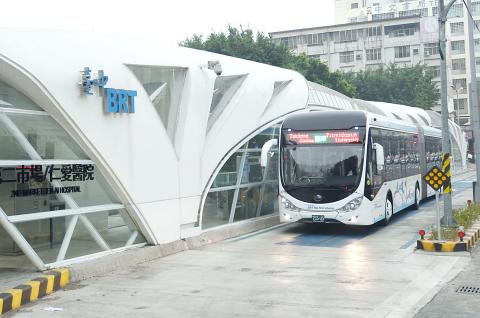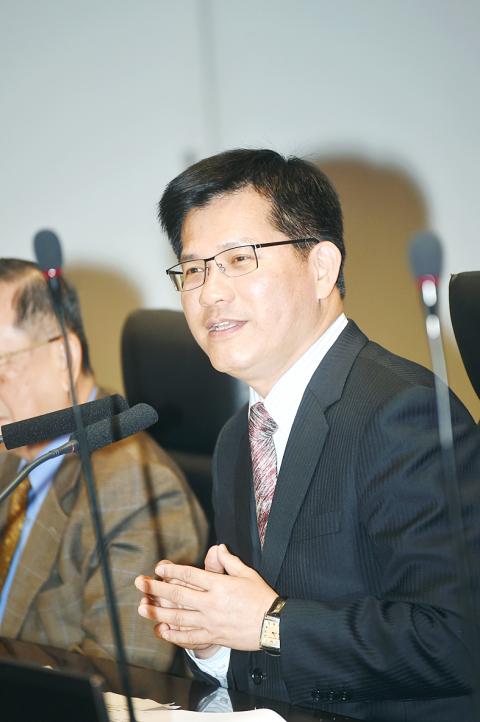The problem-plagued Bus Rapid Transit (BRT) system in Taichung, launched in July last year, is to be abolished after Taichung Mayor Lin Chia-lung (林佳龍) yesterday announced that the BRT lanes would be replaced with “optimized, dedicated bus lanes” starting on July 8.
Lin made the announcement at a city administration meeting.
He declined to describe the move as the “abortion” of the system, instead calling the city’s existing system “stillborn,” as BRT buses do not possess exclusive road rights or priority traffic signals, and the BRT traffic control center cannot communicate directly with the buses while they are on the road or at its stations.

Photo: Liao Yao-tung, Taipei Times
Under the new policy, existing BRT lanes would be exclusively for public buses that currently run on the dedicated bus-only lanes on Taiwan Boulevard (台灣大道) — the main road through the heart of the city — while BRT double-carriage buses would continue to run on the lanes after concerns over safety are addressed, the Taichung Transportation Bureau said.
About 30 percent of the public buses on Taiwan Boulevard would then be allowed to travel on the dedicated bus-only lanes, leaving slower lanes for motorists and motorcyclists, while at lease two bus lines on Taiwan Boulevard would continue to operate on the slow lanes for passengers using minor stations, the bureau said.
All the buses running on the “optimized dedicated bus lanes” would have a uniform look so that they can be easily identified, Lin said.

Photo: Liao Yao-tung, Taipei Times
“Their new livery will become Taichung’s new mobile landmark,” he added.
Lin said that decision would save the city government NT$28 billion (US$893.1 million) previously allocated for the completion of existing BRT lanes — and an additional five BRT lanes — adding that the money would be used to improve the city’s traffic management.
The city government contracted a team of experts to examine and review the BRT system after Lin took office in December last year.
The report was concluded on Saturday.
Lin said that the “optimized dedicated bus lanes” program integrates two proposals — “BRT Plus Bus” and “Pure Bus” — among the four suggested by the team.
The other two suggestions — “Pure BRT” and “BRT Plus Bus plus priority traffic signals” — were not accepted, after an evaluation found the difficulties in implementation were insuperable, Lin said.
The BRT system was the subject of heated debate among Taichung candidates in the nine-in-one elections in November last year.
When the system was launched by then-mayor Jason Hu (胡志強) of the Chinese Nationalist Party (KMT), Lin, a member of the Democratic Progressive Party, criticized Hu for rushing it through in a bid to garner votes in his re-election effort.
Lin said yesterday that the system was a failure in its establishment and operation.
Some motorists have complained about traffic congestion and what they describe as difficulty changing lanes, since BRT stations and lines were built on the islands between slow and express lanes.
A motorist surnamed Liu (劉) expressed disapproval of the new program, saying it would not make it any easier to change lanes and could increase the likelihood of an accident with more public buses running on the lanes.
Having the BRT lanes accommodate so many buses would only slow traffic, an unidentified KMT Taichung city councilor reportedly said, adding that Lin opposed the BRT just because it was a project of Hu’s.
The Ministry of Transportation and Communications later yesterday said that it would not ask the Taichung City Government to return the NT$163 million appropriated by the city to subsidize the construction of the BRT system.
The budget was given to the city to build the bus system and for the operator to purchase buses, ministry official Hu Ti-chi (胡迪琦) said, adding that, as the city plans to continue using the facilities despite the decision it made regarding the BRT lanes yesterday, the ministry would not ask the city to return the money.

ANOTHER EMERGES: The CWA yesterday said this year’s fourth storm of the typhoon season had formed in the South China Sea, but was not expected to affect Taiwan Tropical Storm Gaemi has intensified slightly as it heads toward Taiwan, where it is expected to affect the country in the coming days, the Central Weather Administration (CWA) said yesterday. As of 8am yesterday, the 120km-radius storm was 800km southeast of Oluanpi (鵝鑾鼻), Taiwan’s southernmost tip, moving at 9kph northwest, the agency said. A sea warning for Gaemi could be issued tonight at the earliest, it said, adding that the storm is projected to be closest to Taiwan on Wednesday or Thursday. Gaemi’s potential effect on Taiwan remains unclear, as that would depend on its direction, radius and intensity, forecasters said. Former Weather Forecast

As COVID-19 cases in Japan have been increasing for 10 consecutive weeks, people should get vaccinated before visiting the nation, the Centers for Disease Control (CDC) said. The centers reported 773 hospitalizations and 124 deaths related to COVID-19 in Taiwan last week. CDC Epidemic Intelligence Center Director Guo Hung-wei (郭宏偉) on Tuesday said the number of weekly COVID-19 cases reported in Japan has been increasing since mid-May and surpassed 55,000 cases from July 8 to July 14. The average number of COVID-19 patients at Japan’s healthcare facilities that week was also 1.39 times that of the week before and KP.3 is the dominant

The Chinese Communist Party’s (CCP) working group for Taiwan-related policies is likely to be upgraded to a committee-level body, a report commissioned by the Mainland Affairs Council (MAC) said. As Chinese President Xi Jinping (習近平) is increasingly likely to upgrade the CCP’s Central Leading Group for Taiwan Affairs, Taiwanese authorities should prepare by researching Xi and the CCP, the report said. At the third plenary session of the 20th Central Committee of the CCP, which ended on Thursday last week, the party set a target of 2029 for the completion of some tasks, meaning that Xi is likely preparing to

US-CHINA TRADE DISPUTE: Despite Beijing’s offer of preferential treatment, the lure of China has dimmed as Taiwanese and international investors move out Japan and the US have become the favored destinations for Taiwanese graduates as China’s attraction has waned over the years, the Ministry of Labor said. According to the ministry’s latest income and employment advisory published this month, 3,215 Taiwanese university graduates from the class of 2020 went to Japan, surpassing for the first time the 2,881 graduates who went to China. A total of 2,300 graduates from the class of 2021 went to the US, compared with the 2,262 who went to China, the document showed. The trend continued for the class of 2023, of whom 1,460 went to Japan, 1,334 went to